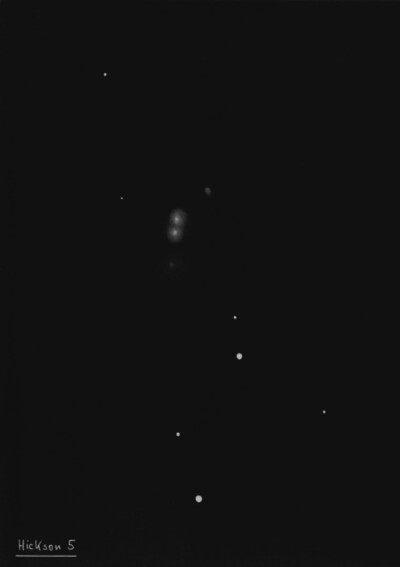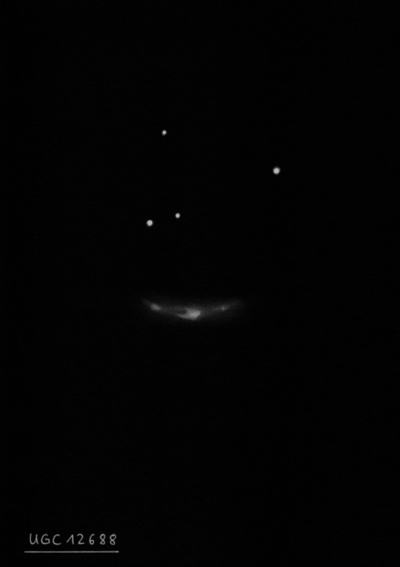A large, faint constellation of the zodiac lying almost entirely in the northern sky between Aries and Aquarius. On its long journey along the ecliptic, the Sun enters the constellation of Pisces on March 11 and remains there until April 17, so it is best seen in the evening sky from October to December. In the constellation south of the star ω Piscium lies the vernal point - the intersection of the ecliptic with the celestial equator. It is the point where the Sun passes through the celestial equator and heads further into the northern hemisphere. It is the time of the vernal equinox, which occurs annually around March 21. In the northern hemisphere it marks the beginning of spring, in the southern hemisphere it marks the beginning of autumn. This intersection is also the starting point of the celestial longitude coordinate - the rectangular line is calculated from it. Declination, or the equivalent of latitude, is calculated from the celestial equator. As a result of precession, the position of the spring point changes. More than 2000 years ago, this imaginary point was located in the constellation Aries.
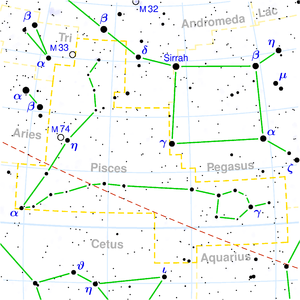 From the perspective of the ordinary amateur astronomer eager to see a few cosmic beauties, this constellation is not very interesting. The line of fainter V-shaped stars encircling Pegasus square in the illuminated city can only be discerned with certainty once the atmosphere has been cleared, and even under the darker skies of the countryside no deep-sky object was seen in the binocular. Indeed, Pisces lies quite far from the Milky Way belt, and although it occupies a good portion of the sky, it includes only a few nice binaries, some of which are color contrast pairs. There is no shortage of faint, relatively small galaxies, some visible in ordinary 200mm binoculars as hazy patches of light, but visually uninteresting in larger amateur telescopes. The most beautiful formation of the constellation is probably the ring of seven stars of about 4th magnitude, sometimes called the Ring Ornament. It represents the head of the more southerly placed fish and consists of the stars γ, κ, λ, ι, θ, 7 and 19 Piscium. The eastern fish is marked by the stars σ to φ Piscium.
From the perspective of the ordinary amateur astronomer eager to see a few cosmic beauties, this constellation is not very interesting. The line of fainter V-shaped stars encircling Pegasus square in the illuminated city can only be discerned with certainty once the atmosphere has been cleared, and even under the darker skies of the countryside no deep-sky object was seen in the binocular. Indeed, Pisces lies quite far from the Milky Way belt, and although it occupies a good portion of the sky, it includes only a few nice binaries, some of which are color contrast pairs. There is no shortage of faint, relatively small galaxies, some visible in ordinary 200mm binoculars as hazy patches of light, but visually uninteresting in larger amateur telescopes. The most beautiful formation of the constellation is probably the ring of seven stars of about 4th magnitude, sometimes called the Ring Ornament. It represents the head of the more southerly placed fish and consists of the stars γ, κ, λ, ι, θ, 7 and 19 Piscium. The eastern fish is marked by the stars σ to φ Piscium.
Al Rischa (α Psc) - From an astronomical point of view, Al Risch is a close binary star (total magnitude 4), with its pale blue components of magnitude 4.3 and 5.2 orbiting each other with a period of 933 years. Currently, they are separated by 1.5" in the sky, requiring a telescope with a 300 mm objective diameter to resolve them. Even at 200x magnification, they appear in close contact. However, due to their orbit, the separation decreases gradually each year, reaching its lowest value of 1" in 2060. The system is located at a distance of 130 light-years and both components are also a spectroscopic binary.
ζ Psc - A nice optical double star with components of 5.6mag and 6.5mag, separated by 23.6". However, in reality, one is located at a distance of 150 light years and the other at 195 light years. The primary component appears white, while the companion has a yellow color. During a good night, it can be easily observed with binoculars, and a small telescope will also work without any problems.
TX Psc - A very interesting irregular variable star, also known as 19 Piscium. The range of its magnitude is from 6.9 to 7.7 and it seems to have no hint of periodicity. TX Psc, with a spectral class of N, is one of the reddest stars within reach of a telescope. In the same field of view, there are ι Psc (4.1 mag) and λ Psc (4.5 mag).
ψ Psc - Wide double star visible in a hand lens. It consists of two components with magnitudes of 5.5 and 5.8, separated by 30". Both have a light blue color and are located 230 light-years away.
55 Psc - A nice double star, in which the primary component has a brightness of 5.6 mag and the companion 8.8 mag. Since they are separated by 6.6", we need a telescope with an objective diameter of at least 6 cm to resolve them. The contrast is intense, with one component having a yellow-orange color and the other a blue color.
42 Psc - This binary star can be easily distinguished with a telescope with a 100 mm objective diameter. It consists of an orange primary component with a brightness of 6.2 magnitude and a companion located 28.5" away with a magnitude of 10.
Van Maanenova hviezda - Wolf 28, a rare example of a relatively well-visible white dwarf, which requires a 200 mm telescope at its brightness of 12.3 mag. This one of the first discovered white dwarfs can be found near the star δ Psc. It is located in close proximity to our Sun, at a distance of 13.8 ly.
38 Psc - Multiple star, attractive pair of yellow stars in a cluster of faint stars. The AB pair is indistinguishable and is perceived as a 7.9 magnitude object, but at a separation of 4.3", we can see a 7.8 magnitude companion. Another, this time of 12th magnitude, lies 63" southeast.
M 74
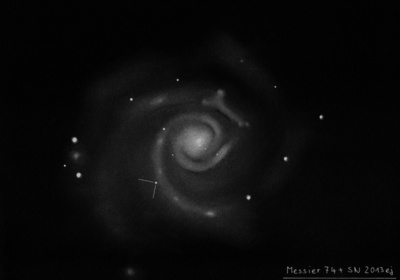
Pierre Méchain discovered M74 = NGC 628 = h142 in September 1780. William Herschel made several observations of M74 in which he claimed to partially resolve it into a number of extremely faint stars. On 14 Oct 1784 (sweep 289) he logged, "easily resolvable; some stars visible in it, the coma eF at the edges and not resolvable."
On 13 Dec 1848, Lord Rosse and/or assistant Johnstone Stoney detected spiral structure with the 72" and noted "Rough sketch made. Spiral?" The next night he "confirmed last night's observations; feel confident it is a spiral." LdR classified M74 as "Spiral or curvilinear" in his 1850 paper.
200/250mm - 8" (8/24/84): very small bright core surrounded by a large faint halo.
300/350mm - 13.1" (8/24/84): very prominent, fairly small bright core surrounded by a very large, diffuse glow. Visible in 16x80 finder.
400/500mm - 17.5" (8/31/86): bright, large, round, very bright core. A spiral arm is attached at the east side of core winding towards the west along the south side. A dark gap is visible between the arm and the main central portion. Several stars are superimposed in the halo.
900/1200mm - 48" (10/22/11): beautiful face-on spiral with long, graceful arms wrapping around an intense 1' core that increases towards the center, but there is no sharp nucleus. At first glance at 375x there appeared to be four arms, but with a more careful look there are two main arms that each wrap more than 360° around the core as well as a couple of side branches. Each arm is studded with a number of non-stellar HII regions that highlight the arms. In addition, a number of stars are superimposed, both in the inner region (two faint stars are within 25" of the center) and around the edge of the halo, which extends to 7'-8' diameter.
The more prominent arm "southern" arm is very regular - emerging from the core on the south side and wrapping counterclockwise around the core to the north, unwinding gradually as it curves to the east and then pulls away from the central region more suddenly on the south side. This arm is very patchy and delineated by a large number of HII knots with the two most prominent ones near the outer southern end. The "northern" arm begins to emerge from north of the core, tightly wraps counterclockwise around the core, passing near or through a few superimposed stars on the south side of the core, unwinding more as it stretches again to the north. The arm structure is a bit more complex on the north side due to side branches and the embedded HII knots are more scattered.
The HII regions were viewed more carefully at 610x. The following identifications are from Paul Hodge's 1976 "HII regions in NGC 628" (ApJ, 205, 728), which lists over 700 HII knots. The brightest is #627, near the end of the outer southern arm 2.7' SSW of center. It appeared fairly bright, fairly small, round, ~20" diameter. Moving clockwise along this arm towards the core, the next prominent knot is #598 situated 2.2' SSE of center. It was slightly fainter than #627, round, 15" diameter. Next in line is #552, a faint round knot of 10" situated 1.8' SE of center. East of the core by 1.5' is #406, a very faint, round 10" knot situated 36" S of a superimposed mag 14.5 star. Just 30" W of this star and 1.2' NE of center is #292, a fairly faint, very small knot, ~8" diameter. Continuing inward along this arm, the next knot is #196, a very faint hazy spot 1.3' N of center. Finally, less than 1' NW of center is another very faint patch with multiple Hodge numbers #260-268.
There were no notable knots on the inner southern portion of the northern arm, but a noticeable clump of knots is on the NW portion of this arm. First was #167/168, a faint 10" knot 1.6' NW of center. Continuing outward 2.0' NNW of center is a faint, elongated patch, ~25" diameter, consisting of #91-95 and #49 at the north end of the glow. I didn't search the outer region of the halo for additional HII knots, except noted #330, a 10" knot situated between two mag 12-13 stars at the eastern edge of halo, 3.9' from center.
Notes by Steve Gottlieb
NGC 100
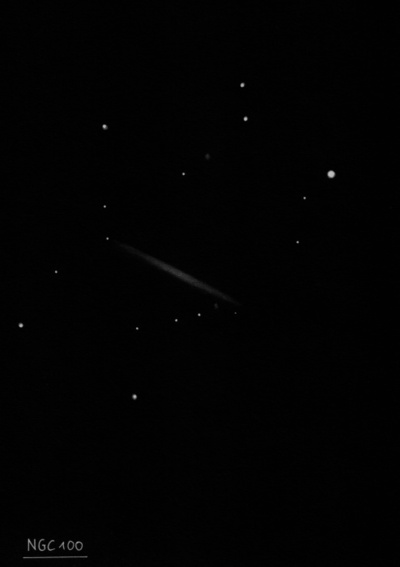
Lewis Swift discovered NGC 100 = Sw. III-1 on 10 Nov 1885 with a 16" refractor at his Warner Observatory. His description reads "vF; pS; vE" and the position matches UGC 231 = PGC 1525, the flattest galaxy in the NGC. Guillaume Bigourdan observed the galaxy on 7 Sep 1891 and mentioned its "form and extension are incredible."
400/500mm - 17.5" (10/8/88): very faint, thin edge-on 7:1 WSW-ENE, moderately large, 2.0'x0.3', weak concentration. NGC 99 lies 42' S.
900/1200mm - 48" (11/8/15): bright, extremely large and thin edge-on 10:1 WSW-ENE, extends at least 4.0'x0.4'. A brighter central region extends ~2' in length and the outer extensions fade significantly and taper towards the tips as they dim out. A mag 15.3 star is just beyond the east end of the galaxy. Four mag 15.2-16.2 stars (in an E-W string) lie within 2.5' south of the galaxy.
PGC 1509358 is just south of the southwestern tip of the galaxy. At 488x it appeared very faint (V = 17.2), very small, slightly elongated, ~10"x7". With careful averted vision, I could just hold the galaxy continuously. A fairly difficult mag 17+ star is 30" SW. The redshift based light-travel time (based on z = .10) is 1.2 billion years.
Notes by Steve Gottlieb
NGC 524
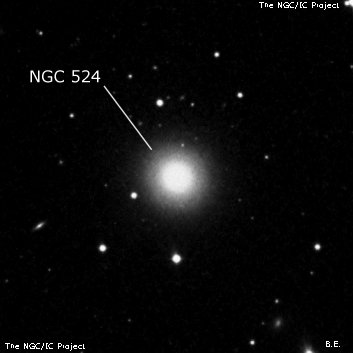
William Herschel discovered NGC 524 = H I-151 = h117 on 4 Sep 1786 (sweep 581) and logged "cB, cL, R, cometic, vgmbM to a nucleus, several small stars near." On 8 Jan 1828 (sweep 118), John Herschel desribed this object as "vB; pL; R; psmbM; 60"; 4 st near." The NGC position is accurate.
200/250mm - 8" (11/8/80): fairly faint, round, bright core. Located just north of a mag 10 star.
300/350mm - 13.1" (8/24/84): bright, small very bright core surrounded by fainter round halo.
400/500mm - 17.5" (10/17/87): very bright, fairly large, very bright core, large faint halo, bright stellar nucleus. A mag 11 star is 2.5' S. Brightest in the NGC 524 group including NGC 505, NGC 509, NGC 516, NGC 518, NGC 522, NGC 525, NGC 532.
Notes by Steve Gottlieb
NGC 488
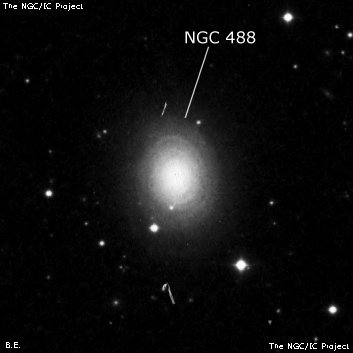
William Herschel discovered NGC 488 = H III-252 = h103 on 13 Dec 1784 (sweep 338) and recorded "vF, pL, iR, lbM." John Herschel gave a more detailed description on 24 Sep 1830 (sweep 300): "B; L; svmbM, and losing itself imperceptibly; resolvable in centre with 320x; *7m in parallel 1 min following." The NGC position is accurate.
400/500mm - 17.5" (11/1/86): bright, large, very bright core, oval 4:3 ~N-S. A mag 11 star is at the south edge just 1.6' SSE of center and a mag 10 star lies 3' SW. Located 9' W of mag 8.3 SAO 109832. In a group with NGC 490 8' NE, NGC 488 5.5' N and NGC 500 18' NE.
Notes by Steve Gottlieb
NGC 741
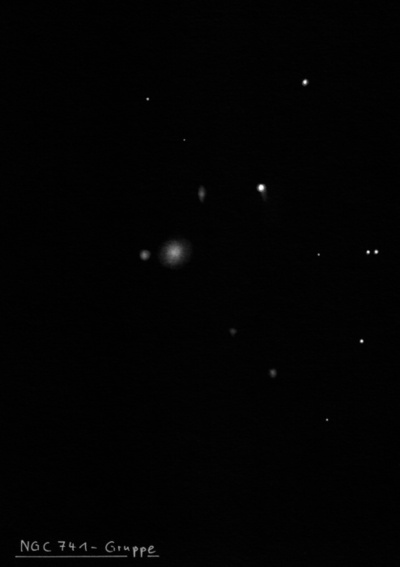
200/250mm - 8" (1/1/84): faint, round, diffuse edges, small faint core. A mag 12 star is close NW.
400/500mm - 17.5" (11/6/93): moderately bright, round, prominent core, faint stellar nucleus at moments, larger halo with averted. A mag 11 star is 2.4' NW. In a common halo with NGC 742 attached at the east end at 0.8' separation in pa 100°. Brightest in a group and forms a close triple with MCG +01-06-006 1.5' NNW. CGCG 413-006 (generally misidentified as IC 1751) appeared very faint, very small, slightly elongated N-S. A mag 10.5 star lies 1.3' WNW.
600/800mm - 24" (12/21/16): at 375x; bright, moderately large, round, sharply concentrated with a small very bright core that increases to the center. The halo increases with averted to over 1'. A mag 11 star is 2.4' NW. NGC 741 is the brightest in a group (WBL 061) with NGC 742 0.8' E of center, at the edge of the halo. NGC 741 has a extended X-ray halo reaching a distance of 19' from its center. Furthermore, twin radio jets emerge from the nucleus of NGC 742 and spread into a larger lobe that encircles NGC 741. A total of 8 members of the group were logged within 15' of NGC 741.
CGCG 413-006 (often misidentified as IC 1751) is 1.5' NW. It appeared faint or fairly faint, very small, slightly elongated N-S, 0.3'x0.2', sharp stellar nucleus. The mag 11 star lies 1.4' W.
CGCG 413-002, 3.3' SW of NGC 741, appeared faint to fairly faint, very small, round, 12" diameter.
CGCG 413-001, 9.5' NW of NGC 741, is very faint, very small, elongated ~2:1 ~E-W, 18"x9". Not noticed initially but once picked up could just hold continuously with careful averted vision.
CGCG 413-010, 11' NNE of NGC 741, is faint, very small, irregularly round, ~15"x12".
UGC 1425, 12' NE of NGC 741, is fairly faint to moderately bright, small, roundish, 18" diameter, high surface brightness (core only), occasional sharp stellar nucleus. Increases a bit in size with averted.
UGC 1435, 15' E of NGC 741, is faint, fairly small, oval 3:2 SW-NE, 30"x20", very low surface brightness patch, no core or zones. Collinear with two 14th magnitude stars 2' and 3' E.
Notes by Steve Gottlieb
NGC 660
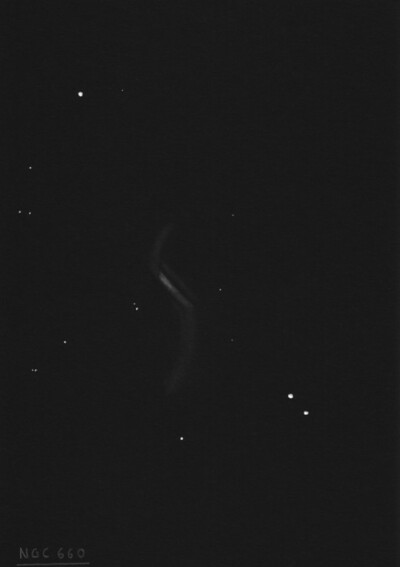
William Herschel discovered NGC 660 = H II-253 on 16 Oct 1784 (sweep 295) and noted "pB, pl, E, bM, r". Sir Robert Ball, an assistant with the 72" at Birr Castle, described "a fine neb of the character of the neb in Andromeda. cB, vL, E 37.1°, possibly curved and with details. E Nucl which was suspected to be in two parts or have some peculiarity." A later observation by Dreyer reads "pB, pL mE 41°. Looks like a brush, fades away gradually south-following, more sharply defined north-preceding. Condensation in nf end."
400/500mm - 17.5" (12/18/89): fairly bright, large, oval SW-NE, broadly concentrated halo, mottled. A mag 14 double star is 1.8' ESE of center. Located 10' SE of mag 8.1 SAO 92589. UGC 1195 (possibly = IC 148) lies 22' NNW. It appeared faint, moderately large, oval SW-NE, low even surface brightness. NGC 660 and IC 148 are members of the loose M74 group.
900/1200mm - 48" (10/23/11): this large, striking galaxy contains a very bright, elongated bar oriented SW-NE, ~2'x1'. The northeastern half of the bar is noticeably brighter with a very high surface brightness. The galaxy is fainter and wider on the southwest portion of the bar. The central region in mottled and dusty, but I didn't notice the X-shaped dust lanes visible on photos. At the southwest end, a broad low surface brightness spiral arm emerges and sweeps south, curving slightly east for a length of 2'. A second faint arm begins at the northeast end of the bar and extends north a similar distance, bending gradually to the west. The arms gave the galaxy a stretched "S" appearance and significantly increased the overall size to ~6.5'x2.5', roughly N-S.
Notes by Steve Gottlieb
NGC 520
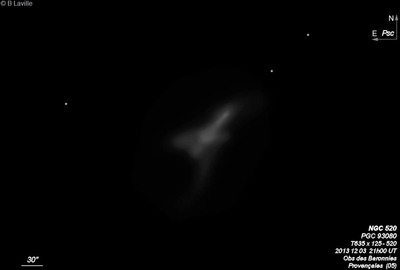
William Herschel discovered NGC 520 = H III-253 = h116 on 13 Dec 1784 (sweep 338) and remarked "eF, cL, E." On 3 Dec 1787 (sweep 788), he reported "cL, E from sp to nf." John Herschel reported on 16 Oct 1827, "pB; E like a comet, pos 135°±; 60" length". Using LdR's 72", Bindon Stoney wrote on 18 Dec 1851, "South end is like a brush or broom with a split in it." His sketch was included in the 1861 publication (as well as 1880). A second observation on 9 Nov 1876 reads "Lord Rosse thought it had two points of condensation 3/4' apart. I (Dreyer) thought it spread out in the following end like a fan. Not well seen." This galaxy is in Arp's category of disturbed galaxies with interior absorption.
200/250mm - 8" (11/28/81): faint, diffuse, elongated N-S.
400/500mm - 17.5" (1/1/92): fairly bright, moderately large, elongated 5:2 NW-SE, 3.0'x1.2'. Very unusual appearance; the NW portion is noticeably brighter with a bright knot at the NW tip and a mottled texture. Fades towards the SE where it merges into a fainter section which is tilted ~E-W with an irregular surface brightness and ill-defined edges.
900/1200mm - 48" (10/22/11): the view of this very bright, highly irregular, disrupted galaxy was fascinating at 488x. The most prominent feature is a very high surface brightness curving "bar" oriented NW-SE (VV 231a), bending out in the middle towards the southwest, and fading out on the southeast end with a faint extension. The total length of the banana-shaped bar is close to 2.5'. The brightest part is at the northwest end, where there is a large, bright knot, 24" diameter that increases to the center. In AJ, 134, 212 (2007), Rossa et all refer to this knot as the northern nucleus. The edge of the bar is very well defined along the north side. At the southeast end of the main bar, the brightness dims sharply but a much fainter hazy glow continues further southeast (VV 231c) and spreads out.
On the south side is a fairly bright, elongated section oriented WNW-ESE (VV 231b), that is separated from the northern "bar" by a prominent, irregular dark lane running NW to SE, paralleling the bar in the central region. A slightly brighter "knot" is located is the middle of the southern section. According to the Rossa paper, the dust lane just north of this knot optically obscures the southern nucleus. At the southeast end, the glow dims rapidly and fans out further southeast.
Notes by Steve Gottlieb
NGC 7562
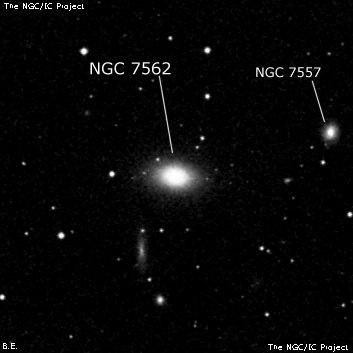
William Herschel discovered NGC 7562 = H II-467 = h2224 on 25 Oct 1785 (sweep 464) and recorded "pB, pL, irr figure." John Herschel made the single observation "B; S; R; psbM; 15"." While observing NGC 7562 on 16 Sep 1852, George Johnstone Stoney, LdR's assistant, recorded "Involves a very small star to north-following. Another nebula [NGC 7557] 6' preceding and 1' north of it."
400/500mm - 17.5" (8/27/87): fairly bright, moderately large, slightly elongated ~E-W, bright core, stellar nucleus.
17.5" (11/1/86): fairly bright, fairly small, strong bright core, fainter halo slightly elongated ~E-W. Forms a pair with NGC 7557 4.7' WNW. NGC 7591 lies 35' ESE and NGC 7564 36' N.
600/800mm - 24" (1/1/16): fairly bright, fairly large, oval 3:2 ~E-W, ~1.2'x0.8'. Sharply concentrated with a very bright core that increases to the center. The much fainter halo gradually fades out at the periphery. A mag 13.8 star is 1.8' E. NGC 7557 lies 4.6' WNW and NGC 7562A is 2.3' SSE. Two extremely faint "stars" [mag 16.3 or fainter] were glimpsed close to the position of NGC 7562A and one of these may have been the core of the galaxy as it occasionally seemed non-stellar and possibly elongated N-S.
Notes by Steve Gottlieb
NGC 266
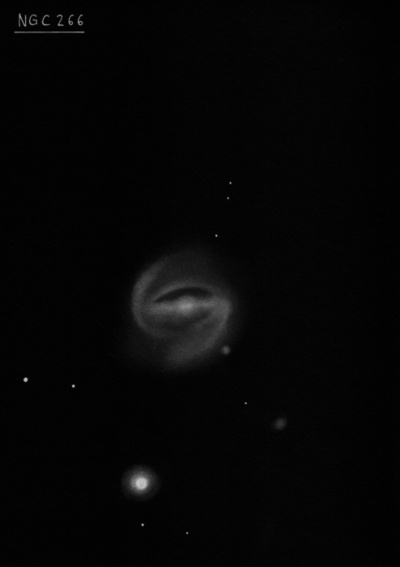
William Herschel discovered NGC 266 = H III-153 = h65 on 12 Sep 1784 (sweep 268) and noted "vF, pL, lE, r, very little brighter towards the following side." JH observed this 4 times and at Birr Castle 5 times with the 72-inch. On 18 Sep 1857 it was described as "S, pB disc, in vF haze of mottled nebulosity, which seems brightest in a line p and f." E.E. Barnard found it in Feb 1889 while sweeping with the 12-inch refractor at Lick Observatory and noted it as "R, 1' +/- or less, bM to faint nucleus of 13m."
400/500mm - 17.5" (11/25/87): fairly bright, moderately large, elongated ~E-W, bright core, stellar nucleus. Located on the Andromeda border 4' N of mag 8.2 SAO 54174.
Notes by Steve Gottlieb
NGC 7541
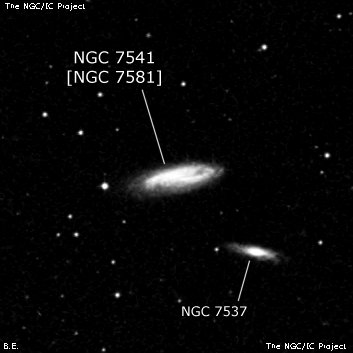
200/250mm - 8" (11/8/80): faint, fairly large, edge-on E-W. A mag 12.5 star is close east. Forms a pair with NGC 7537 3' SW. Located in the Pisces Circlet.
400/500mm - 17.5" (8/10/91): bright, fairly large, edge-on 4:1 WNW-ESE, 3.0'x0.75', large slightly brighter middle bulges. Has an irregular surface brightness with mottling and appears brighter on the west side. A mag 12 star is off the east edge 2.1' from center. Forms a striking pair with NGC 7537 3.1' SW.
Notes by Steve Gottlieb
NGC 128
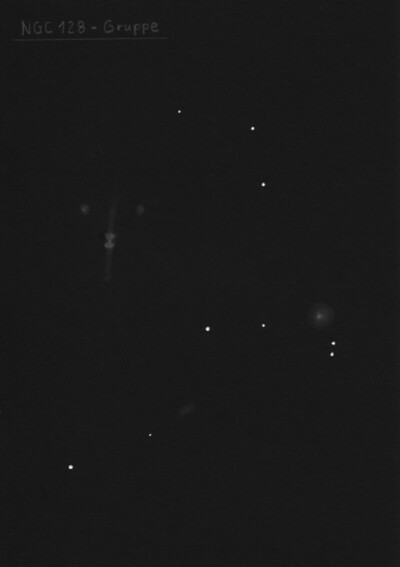
William Herschel discovered NGC 128 = H II-854 = h25, along with NGC 125, on 25 Dec 1790 (sweep 985) and logged "pB, vS, R, vgmbM, pretty well defined on the margin". Using the 72" on 12 Dec 1874, Dreyer recorded "cE in PA 2.4°, mbM, probably sharp on f side, and a little curved, convex side f; two stars (or eS nebulous knots perhaps?) follow very near."
200/250mm - 8" (8/16/82): faint, small, elongated N-S.
300/350mm - 13.1" (11/5/83): fairly bright, fairly small, spindle N-S.
400/500mm - 17.5" (10/8/88): moderately bright, fairly small, very elongated 3:1 N-S, bright core, stellar nucleus. Brightest in a group of five with two extremely close companions: NGC 127 0.8' NW and NGC 130 1.0' ENE. NGC 125 lies 6' WSW.
Notes by Steve Gottlieb
NGC 676
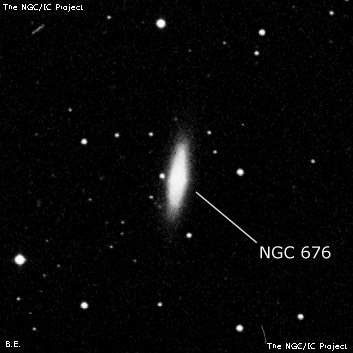
William Herschel discovered NGC 676 = H IV-42 = h151 on 30 Sep 1786 (sweep 607) and recorded "a star with vF branches in the direction of the meridian, each branch about 1' in length; the star about 8 or 9 m; other stars of the same size are free from these branches". Interestingly, he used this example in his 1814 PT paper to argue, not only of the association of the star [very near the center] and the nebula, but that the nebula was brighter near the star because nebulous matter was being drawn by gravity to the star. John Herschel made two observations and logged on 24 Sep 1830, "a *9m with a vF narrow ray of nebulosity; a most curious object." The galaxy was observed 4 times at Birr Castle. On 8 Nov 1876, J.L.E. Dreyer recorded "*9m with pF neb elongated 168.4°, longer on the side of *, concave preceding, convex following."
The 9.5-mag star superimposed at the center is included in the CGCG magnitude (10.5z). Steinicke notes that the separation from centre is only 9", the smallest value of all cases of bright superimposed stars in the NGC!
400/500mm - 17.5" (12/18/89): very unusual appearance as a mag 10 star (BD +5 244) is superimposed on the core! Fairly faint, very elongated 3:1 NNW-SSE, almost even surface brightness except for the bright star. NGC 693 lies 26' NE.
Notes by Steve Gottlieb
NGC 507
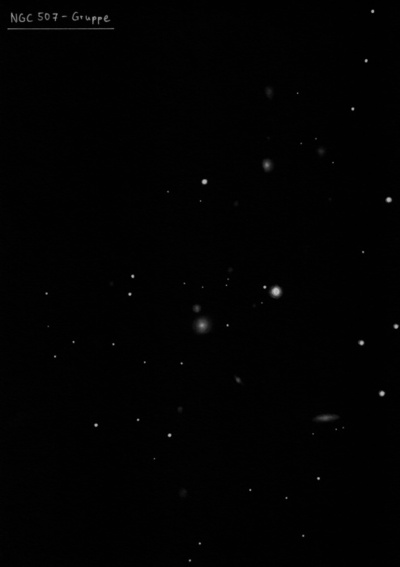
William Herschel discovered NGC 507 = H III-159 = h108, along with NGC 508 = III-160, on 12 Sep 1784 (sweep 268) and recorded both as "Two. Both eF, S, but unequal." John Herschel made 2 observations, calling it "extremely faint" on 17 Nov 1827 (sweep 104) and 5 nights later as "pretty bright".
300/350mm - 13.1" (8/8/86): moderately bright, moderately large, round, very bright core. Second of three with NGC 508 1.5' N and NGC 504 4' SSW in a large group. Located 6' ESE of mag 7.8 SAO 54647.
600/800mm - 24" (10/4/13): bright, moderately large, round, 1.5' diameter, sharply concentrated with a blazing core that increases to the center. The outer halo gradually fades out, so there is no distinct edge, but just beyond the halo on the north side is NGC 508 (1.5' between centers). Brightest in a large group with over 20 members that is part of the Pisces-Perseus Supercluster.
A number of galaxies are nearby including NGC 504 4' SW, IC 1687 4.6' WNW, PGC 5100 3.0' S, CGCG 502-072 5.1' NE ("fairly faint, small, round, 18" diameter") and NGC 503 5.2' NNW. A mag 14.3 star is just off the NW side, 1.3' from center and a mag 15.3 star (= NGC 506) is off the southwest side, 1.3' from center. Mag 7.6 HD 8347 lies 6.2' WNW.
Notes by Steve Gottlieb
NGC 63
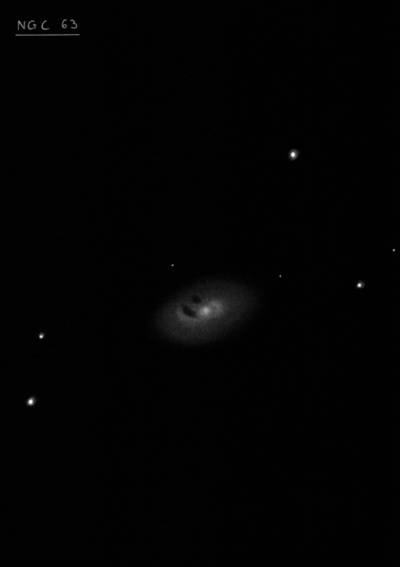
Heinrich d'Arrest discovered NGC 63 = Sf 96 on 27 Aug 1865 with an 11" refractor at Copenhagen and recorded (combining two observations) "class II, round, 35", mag 16 nucleus; lying between two mag 12 and 13 stars, the first precedes the nebula by 9.7 sec." His position and description matches UGC 167.
Truman Safford made an independent discovery on 30 Sep 1867 with the 18.5" refractor at the Dearborn Observatory as well as Hermann Vogel on 16 Aug 1868 (he credited d'Arrest) with the 8.5" refractor at the Leipzig Observatory. Dreyer observed NGC 63 at Birr Castle on 30 Oct 1877 and logged, "pB, pS, oval p f, smbM. Inside a triangle of 3 st 12, one of them in PA 268.9 (W), Dist 143.7", the 2 others about the same distance np and f."
400/500mm - 17.5" (12/19/87): fairly bright, fairly small, very elongated ~E-W, bright core, stellar nucleus.
Notes by Steve Gottlieb
NGC 194
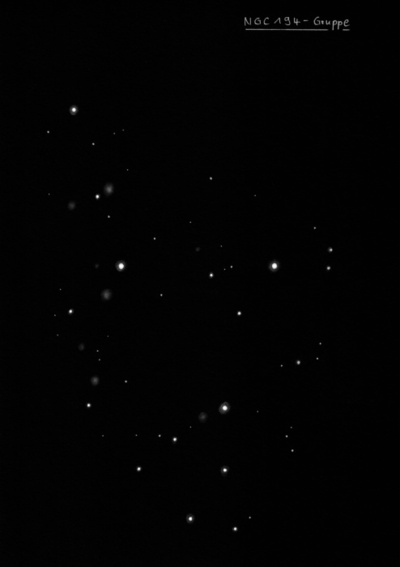
William Herschel discovered NGC 194 = H II-856 = h40 on 25 Dec 1790 (sweep 985) and recorded "F, S, vgbM." JH called it "pB; S; R; bM." The NGC position matches UGC 407 = PGC 2362.
400/500mm - 17.5" (10/8/88): fairly faint, fairly small, round, small bright core, stellar nucleus. Located 5' S of mag 7.3 SAO 109348! Member of the NGC 182 group with NGC 199 6' NE and NGC 200 10' SSE.
600/800mm - 24" (12/12/17): at 375x; bright, fairly small, slightly out of round, ~35"x30". Sharply concentrated with a very bright, very small core and stellar nucleus. A mag 7.4 star is 6' NNW. Near the center of the NGC 182 group with several galaxies near; NGC 200 is 10' SSE, NGC 199 is 7' NE and NGC 186 is 15' NW.
Notes by Steve Gottlieb
NGC 383
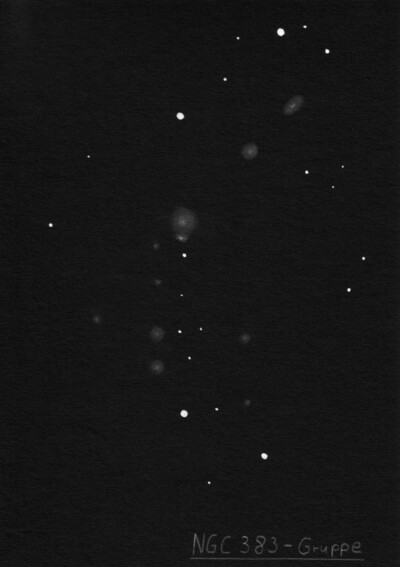
William Herschel discovered NGC 383 = H II-217 = h86, along with NGC 379 = II-215 and NGC 380 = II-216, on 12 Sep 1784 (sweep 268). See description under NGC 379. John Herschel made 3 observations and reported on 22 Nov 1827 (sweep 106), "pB; pL; gbM."
300/350mm - 13.1" (9/29/84): fairly bright, almost round, bright core. Forms a double with NGC 382.
400/500mm - 17.5" (9/19/87): brightest in the NGC 383 cluster. Fairly bright, moderately large, slightly elongated, broadly concentrated halo. Forms a double system with NGC 382 30" SW. NGC 380 is 4.5' NNW, NGC 379 6.8' NNW, NGC 386 3.3' SSE, NGC 385 5.5' SSE.
Notes by Steve Gottlieb
NGC 7714
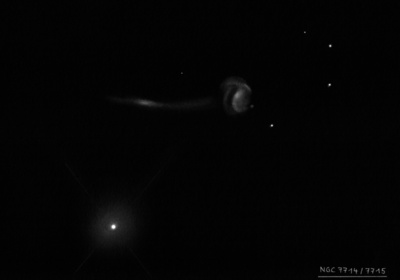
John Herschel discovered NGC 7714 = h2257 on 18 Sep 1830 and recorded "pB; S; R; psbM; in field with 16 Piscium; a star 12m near south preceding (dist = 1 diameter of neb by diagram)." His position is fairly accurate. NGC 7715 was discovered at Birr Castle.
400/500mm - 17.5" (8/7/91): moderately bright, very small, unusually bright 13th magnitude stellar nucleus! Surrounded by a small halo slightly elongated NW-SE. Forms a close pair with NGC 7715 1.8' E. Located 4' NW of 16 Piscium (V = 5.7), which adds to an interesting view! This is a distorted Wolf-Rayet starburst galaxy.
600/800mm - 24" (8/30/16): at 322x; bright, moderately large, irregular shape. Contains a very bright quasi-stellar nucleus and a close knot on the NW side. The halo is irregular in outline. Brighter of a close, interacting pair (Arp 284) with NGC 7715 2' E. The bridge of material connecting the pair was not seen. Located 4' NW of mag 5.7 16 Psc!
900/1200mm - 48" (10/26/16): at 610x; very bright, moderately large, unusual irregular structure, ~1.2' diameter. This deformed, interacting Wolf-Rayet galaxy is dominated by an extremely bright stellar nucleus (starburst activity). A short bar-like central region is elongated NNW-SSE. A curved arm bends sharply west on the south end of the "bar" and contains a very small knot (southwest of the nucleus). A second arm, which appears to consist of a series of HII knots on the SDSS, begins on the NNW end of the "bar" and extends a short distance northeast. A low surface brightness halo appears as a hazy glow on the eastern side only [a tidal loop on the SDSS]. The western tidally stretched arm of NGC 7715 2' E heads towards NGC 7714 but doesn't form a complete bridge.
NGC 7714 is located just 4' NW of mag 5.7 16 Psc and the bright star needs to be kept out of the field. [HB89] 2333+019, an 18th magnitude quasar with a light-travel time of over 10 billion years, faint distant quasar, lies 4.4' ENE of center and was the subject of an article by Howard Banich in the Oct. '17 issue of Sky & Tel.
Notes by Steve Gottlieb
NGC 95
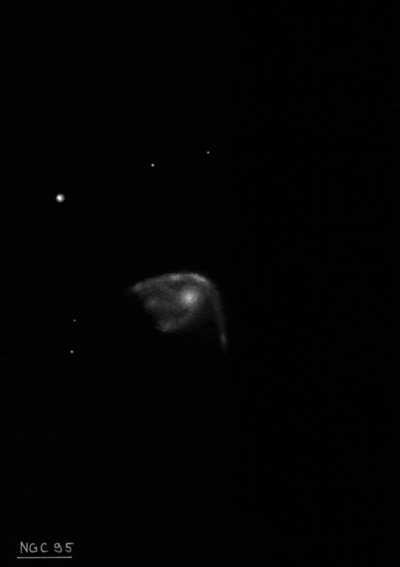
William Herschel discovered NGC 95 = H II-257 = h19 on 18 Oct 1784 (sweep 298) and logged "F, S, R, lbM." He found it again on 23 Nov 1785 (sweep 477) and noted "F, pL, mbM, iR." JH made the single observation "vF; pL; R; gbM."
300/350mm - 13.1" (12/19/87): faint, small, round, weak concentration.
400/500mm - 17.5" (12/19/87): moderately bright, moderately large, round, bright core, very faint stellar nucleus, diffuse halo. A mag 12 star is 2.0' NE of center.
Notes by Steve Gottlieb
NGC 455
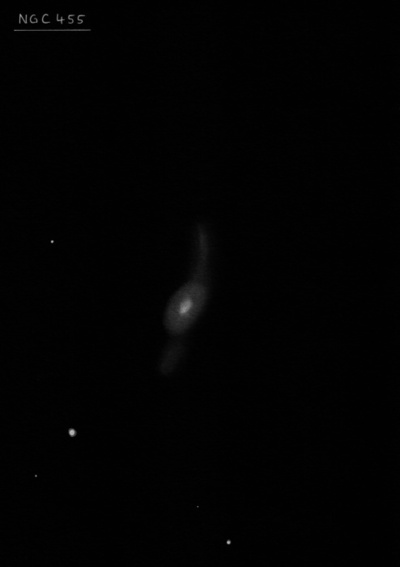
Albert Marth discovered NGC 455 = m 39 on 27 Oct 1864 with Lassell's 48" on Malta and logged "F, vS, alm stell". His position is 1' N of UGC 815 = PGC 4572
400/500mm - 17.5" (10/5/91): fairly faint, fairly small, elongated 3:2 NNW-SSE, bright core. Located 2.5' NW of a mag 10.5 star.
Notes by Steve Gottlieb
NGC 7499
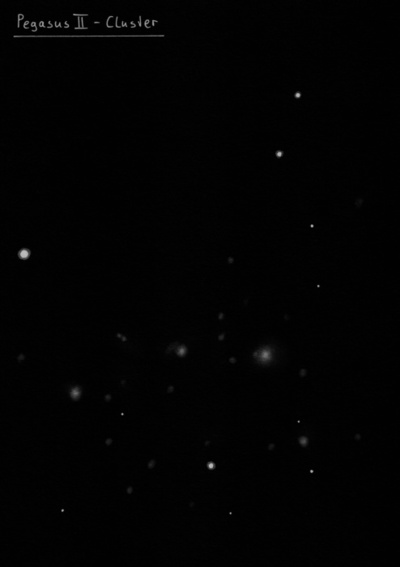
CGCG 406-005 required averted vision using 220x to momentarily glimpse a 20", very low surface brightness circular patch, 3.0' NW of a mag 12.5-13 star. A star appears to be very close or involved or possibly the galaxy contains a faint stellar nucleus. Located ~10' SW of the NGC 7499/7501/7503 trio.
MCG +01-59-002 was also a difficult target and appeared as an extremely faint, small thin sliver, ~0.3'x0.1', but too faint for any details. Collinear with brighter NGC 7499 and NGC 7501 to the east.
Albert Marth discovered NGC 7499 = m 526, along with NGC 7501 and 7503, on 2 Sep 1864 and noted "vF, vS, stellar." His position is accurate.
400/500mm - 17.5" (8/1/87): faint, small, round, weak concentration. First of three with NGC 7501 2.1' ENE and NGC 7503 5.0' ESE. This trio is the brightest in the Pegasus II cluster. Two very faint members, MCG +01-59-002 and CGCG 406-005 are located 5' W and ~8' SW, respectively. Located 14' NNE of mag 7.2 SAO 128008.
Notes by Steve Gottlieb
NGC 7731
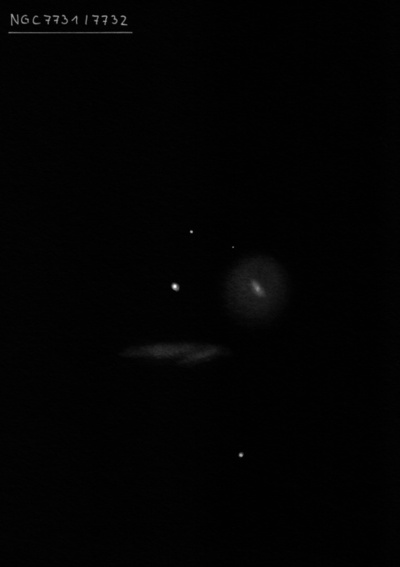
Albert Marth discovered NGC 7731 = m 588, along with NGC 7732, on 27 Oct 1864 and noted "F, S."
400/500mm - 17.5" (11/30/91): fairly faint, small, elongated 3:2 ~SW-NE, small bright core. A mag 11 star is 1.3' E. Forms a close pair with NGC 7732 1.4' SE.
600/800mm - 24" (11/24/14): fairly faint, fairly small. Sharply concentrated with a brighter "bar" oriented SW-NE within a very faint halo increasing the size to ~30". A mag 11 star is 1.3' E and NGC 7732 is 1.5' SE.
IC 1504 lies 17' NNW and appeared fairly faint, fairly small. Sharply concentrated with a brighter "bar" oriented SW-NE in a very faint halo increasing the size to ~30". A mag 11 star is 1.3' E
900/1200mm - 48" (10/26/16): at 610x; bright, moderately large, slightly elongated E-W, 1.0'x0.8', well concentrated with a slightly elongated bright core SW-NE and a sharp, very bright stellar nucleus! Situated just 1.3' W of a distracting mag 11 star. Forms a striking pair with NGC 7732 1.5' SE.
Notes by Steve Gottlieb
NGC 7679
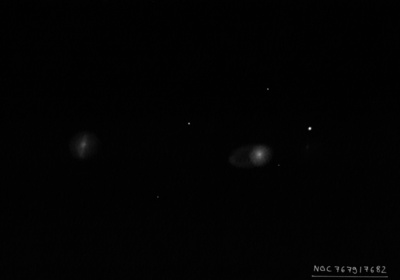
Heinrich d'Arrest discovered NGC 7679 on 23 Sep 1864 with the 11-inch refractor at Copenhagen. His position (measured again 2 nights later with nearby HD 221014) is accurate. Albert Marth independently discovered this galaxy just a month later on 23 Oct 1864 at Malta and noted a "nebulous star 12.5 mag." Surprisingly, Marth missed nearby NGC 7682.
200/250mm - 8" (8/16/82): faint, small bright nucleus surrounded by a small halo.
300/350mm - 13.1" (9/3/83): fairly faint, extremely small, dominated by a very small intense nucleus.
400/500mm - 17.5" (8/1/87): moderately bright, very small, round, very small bright core, stellar nucleus. Forms a pair with NGC 7682 4.3' ENE. A mag 12 star lies 2.4' WNW. Located 5.3' SE of a mag 9.5 star.
600/800mm - 24" (9/29/16): at 200x; moderately to fairly bright, fairly small, round, 25"-30" diameter, high surface brightness. Contains a small bright core that increases to a faint stellar nucleus. Burnham 1222, a close 1.4" pair of mag 10 stars, is 5.2' NW and cleanly resolved at 375x. On the SDSS NGC 7679 appears disrupted and surrounded by an off-center ring or tidal arm with a condensation (former companion?) at the eastern edge (LEDA 1253673). Forms a trio with NGC 7682 (undisturbed) 4.5' ENE and UGC 12628 11.5' SE.
Notes by Steve Gottlieb
NGC 7603
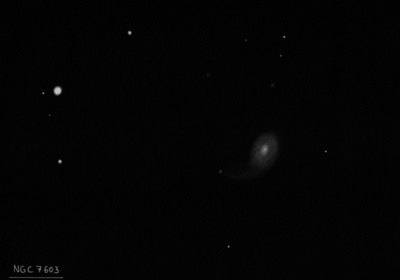
Albert Marth discovered NGC 7603 = m 566, along with NGC 7589, on 23 Oct 1864 and noted "F, vS, stellar." His position is accurate.
There is a long-standing redshift controversy with this pair first mentioned by Arp in ApL, 7, 221, 1971. NGC 7603, the brighter galaxy, has a redshift z = .029 (~390 million ly) while its companion NGC 7603B has a much higher redshift z = .057, placing it about twice the distance (~740 million ly). But there appears to be a luminous bridge connecting the objects that is easily visible on the DSS. Also two quasars with much higher redshifts (z = .391 and z = .243) are embedded exactly on line of sight at the start and end of the bridge.
300/350mm - 13.1" (8/11/85): faint, small, round, sharp concentration, stellar nucleus. Located ~5' W of a mag 9 star.
400/500mm - 17.5" (8/1/87): moderately bright, fairly small, oval ~N-S, sharp concentration, small bright core, stellar nucleus. Forms a pair with NGC 7589 8' WNW. Located 5.1' SW of a mag 9.5 star.
600/800mm - 24" (9/1/16): at 220x; bright, small, round, contains a very small unusually bright core that increases to an extremely bright stellar nucleus (Seyfert galaxy)! Forms a close (line of sight) pair with NGC 7603B 1.0' SE. The companion appeared extremely to very faint, extremely small, only ~6" diameter, required averted to see (V = 15.9, B = 16.7).
900/1200mm - 48" (10/29/16): at 610x; bright, moderately large, round, sharply concentrated with a very bright core and an intensely bright stellar nucleus! The roundish halo gradually fades out around 1.0' diameter. The beginning of a tidal arm is occasionally visible on the south side, extending a short distance to the southeast, but not reaching NGC 7603B. The apparent companion, resides far in the background at a redshift distance of ~740 million ly. It appeared fairly faint, fairly small, round, 0.3' diameter, very small brighter core, stellar nucleus. A hint of the apparent bridge from NGC 7603 is just visible close west, but was not seen as connected.
48" (10/22/11): at 375x, this Seyfert galaxy is unusually sharply concentrated and displayed an extremely bright stellar nucleus surrounded by an intensely bright, 20" core with a much fainter outer halo extending 1.3'x1.0'. Forms a close pair with NGC 7603B = PGC 71041 just 1' SE. At 610x, the small companion is just outside the halo of NGC 7603 and appeared fairly faint, fairly small, round, 20" diameter.
Notes by Steve Gottlieb
NGC 105
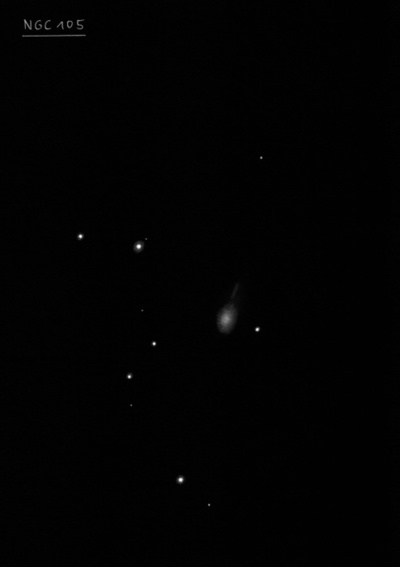
Édouard Stephan discovered NGC 105 = St XIII-4 on 15 Oct 1884 with the 31" reflector at the Marseille Observatory and described as "eF, S, R, vlbM". His position matches UGC 241 = PGC 1583. Lewis Swift independently found the galaxy again on 31 Oct 1886 and reported it in list V-7. His position is just 5 tsec too far W and his comment "inside of and near [the] preceding corner of equilateral triangle" applies.
400/500mm - 17.5" (12/19/87): fairly faint, small, slightly elongated NW-SE, weak concentration. Two mag 13.5 star lie 0.7' W and 1.4' ESE. Situated in a group of six mag 13/14 stars.
Notes by Steve Gottlieb
NGC 485
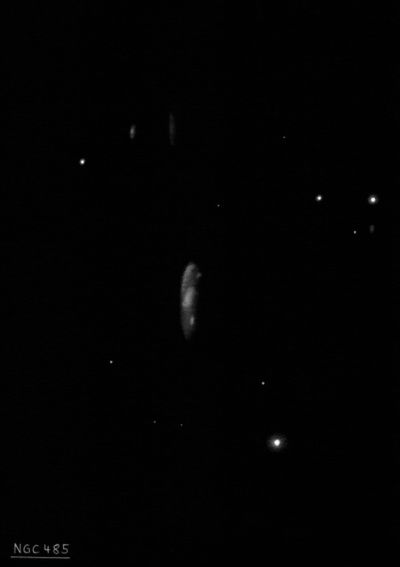
John Herschel discovered NGC 485 = h101 on 8 Jan 1828 and recorded "eF; pL; R; has a red * 7.8m 45 degrees south preceding." Herschel's description and the NGC position (from Heinrich d'Arrest and Herman Schultz) matches UGC 895.
400/500mm - 17.5" (11/30/91): faint, fairly small, elongated 2:1 N-S, weak concentration. Located 3.7' NE of mag 8.6 SAO 109824.
Notes by Steve Gottlieb
UGC 934
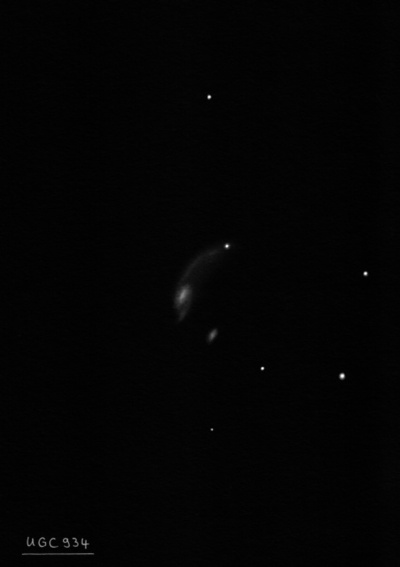
Although Arp classified this system as a "Spiral with a small high surface brightness companion on arm", the stretched (tidal) northern arm of UGC 934, which hooks south towards VV 341b does not appear to reach the small galaxy.
600/800mm - 24" (12/1/16): at 375x; fairly faint, fairly small, elongated 5:3 NW-SE, ~30"x18", broad concentration to center, no distinct nucleus. Forms a close pair with VV 341b = Arp 70 NED1 0.8' SW. The companion appeared very faint, very small, slightly elongated 12"x9". Once identified, it could be held continuously.
Notes by Steve Gottlieb
UGC 1449
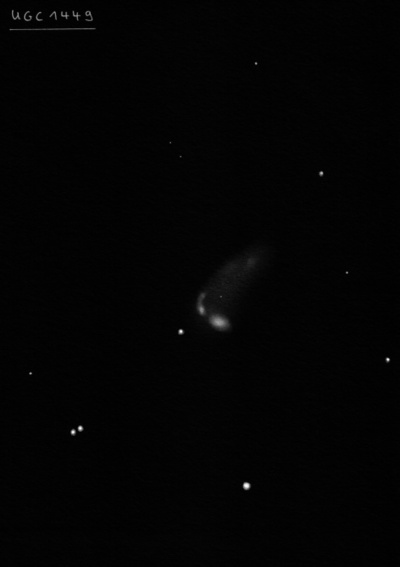
600/800mm - 24" (1/31/14): faint, small, slightly elongated N-S, ~15"x12" diameter. Increases in size with averted to 0.4'x0.3'. This is the fainter NE component of VV 122 = Arp 126 with the two galaxies separated by only 24". In Arp's category of elliptical galaxies close to and perturbing spirals (the SDSS shows this is a disrupted Magellanic-type system with a tidal plume to the NW).
Notes by Steve Gottlieb
UGC 717
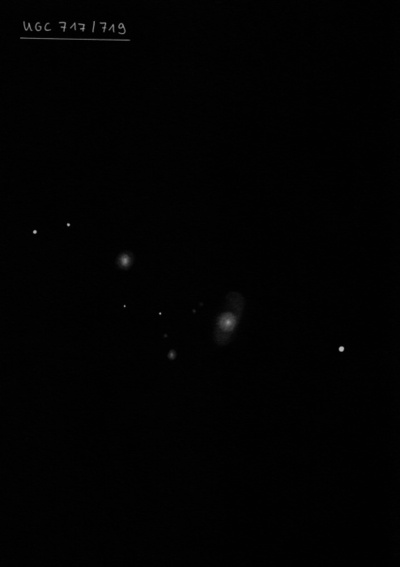
Forms a close pair (VV 348) with much fainter MCG +02-04-004 1.1' SE, though the companion (faint, very small, round, 10" diameter) is apparently in the background at 800 million l.y. UGC 719 is just 2.1' NE, completing a nice compact triplet (no designation). A mag 12 star lies 2.3' WSW. The distance of this galaxy and UGC 719 is ~500 million light years.
600/800mm - 24" (10/5/13): UGC 717 = Arp 11 (category "Spiral Galaxies: split arm") is the brightest in a small triplet. At 375x it appeared fairly faint, fairly small, round, 35", even surface brightness. This description appears to apply to the core region and the low surface brightness arms were not noticed.
Notes by Steve Gottlieb
UGC 849
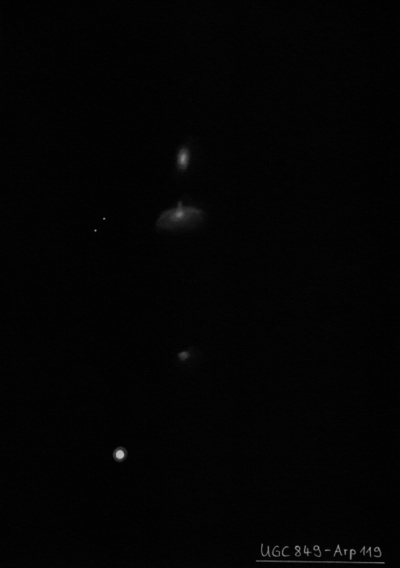
On the SDSS image, UGC 849 is strongly disturbed with an unusual asymmetry. It features an offset nucleus on the north side, a spike or filament extending north towards CGCG 436-023 and numerous blue, thin knotty "sprays" or arcs with extensive star formation.
600/800mm - 24" (10/5/13): at 375x; fairly faint, small, slightly elongated ~E-W, ~25"x20" (central region only seen). This disturbed galaxy (part of Arp 119) forms a close pair with CGCG 436-023 just 0.9' N. Located 4.5' NNW of a mag 9.6 star. PGC 1410939 lies 6' NW and Arp 88 (not seen) is 4.9' WNW. Also Arp 48 is 11' SE.
Notes by Steve Gottlieb
UGC 1191
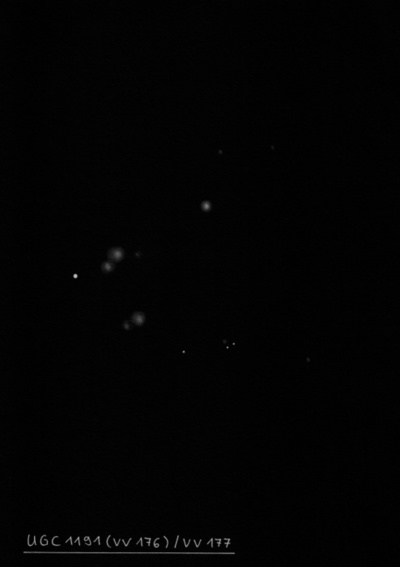
600/800mm - 24" (12/1/13): VV 176a appeared fairly faint, small, round, 18" diameter. A mag 14.5-15 star lies 42" SE. VV 176 is a tight double system (15" separation) and at 375x the companion VV 176b occasionally "popped" as an extremely faint "star" on the SE edge. VV 176 = UGC 1191 is the brightest member of AGC 240 (800 million l.y.) with VV 177 = MCG +01-05-022 just 0.9' SW and 2MASX J01415951+0740508 lies 1.9' NW.
Notes by Steve Gottlieb
NGC 7459
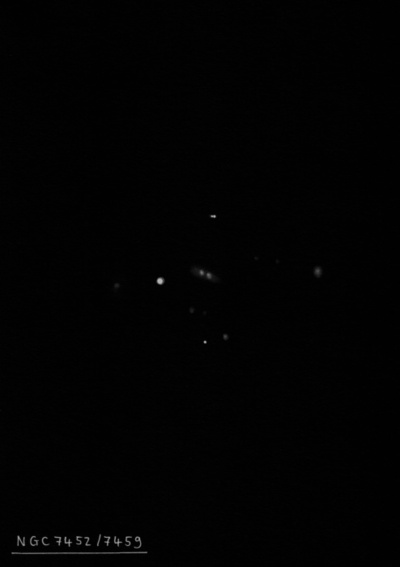
Lewis Swift discovered NGC 7459 = Sw. II-97, along with NGC 7452 and 7455, on 14 Oct 1884 and recorded "eeF; pL; R; * nr; sf of 2 [with NGC 7452]." There is nothing at his position, but Harold Corwin suggests this number applies to UGC 12302 (the brightest in the cluster), located 30 sec of RA due west of Swift's position. This identity was first made by Hermann Kobold in his observation at Strasbourg in 1897 (published in 1907). This implies NGC 7452 = PGC 1306660, which is 21 seconds west of his position.
RNGC, MCG and PGC identify UGC 12302 as NGC 7452. UGC does not apply an NGC designation for this double system. RNGC classifies NGC 7459 as nonexistent (Type 7). See Corwin's notes.
400/500mm - 17.5" (11/18/95): very faint, small, elongated 3:2 WSW-ENE, 40"x25", weak concentration. Located 1.2' W of a mag 13 star. Forms a pair with NGC 7452 3.1' W. This is a double system (not resolved) and brightest in a faint cluster. Listed as nonexistent in RNGC.
600/800mm - 24" (12/28/13): at 200x appeared fairly faint, fairly small, elongated ~5:3 SW-NE, 0.8'x0.5', brighter core. At 282x, the core appeared double [post merger system?], with the two extremely small nuclei just resolved [10" separation], and oriented along the major axis. The northeast component appeared quasi-stellar. A mag 13.2 star is 1.2' E of center.
Notes by Steve Gottlieb
HCG 97
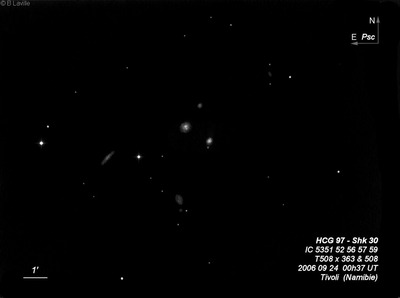
| Type | GALCL [E2] |
| RA | 23:47:26.9 |
| Dec | -02:18:20.0 |
| major_axis | 6.8' |
| mag | 11.5 |
| surface_bright | 99.9 |
HCG 98
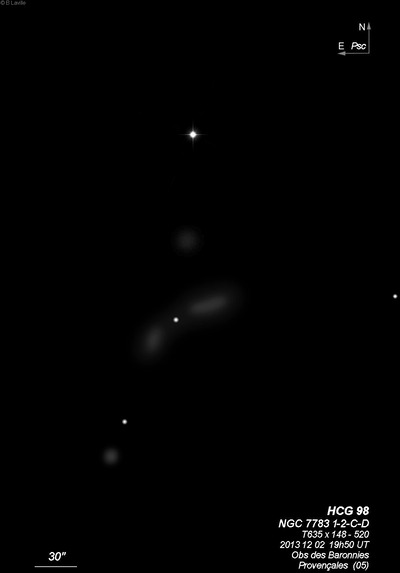
| Type | GALCL [E2] |
| RA | 23:54:12.8 |
| Dec | +00:22:24.0 |
| major_axis | 3.1' |
| mag | 11.5 |
| surface_bright | 99.9 |
HCG 2
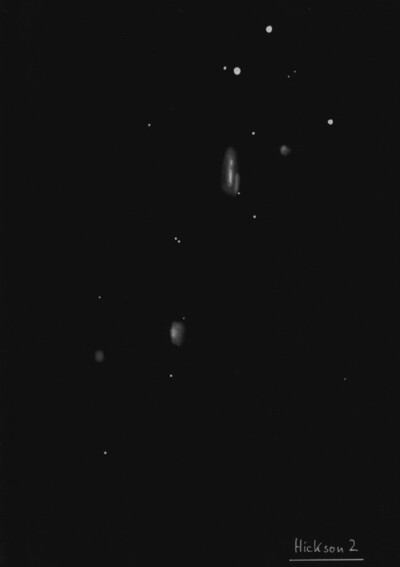
| Type | GALCL [S2] |
| RA | 00:31:30.0 |
| Dec | +08:25:53.0 |
| major_axis | 9.19' |
| mag | 12.1 |
| surface_bright | 99.9 |
